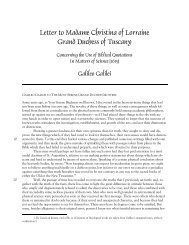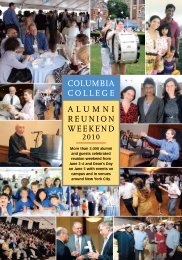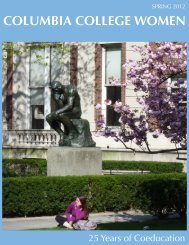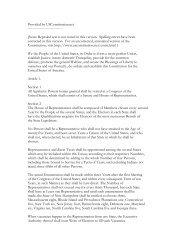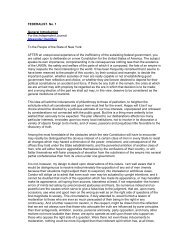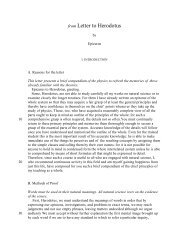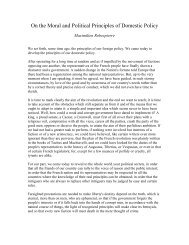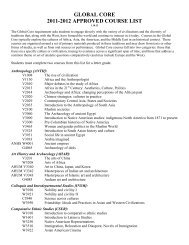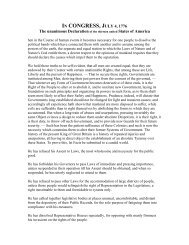A Passion for Science - Columbia College - Columbia University
A Passion for Science - Columbia College - Columbia University
A Passion for Science - Columbia College - Columbia University
Create successful ePaper yourself
Turn your PDF publications into a flip-book with our unique Google optimized e-Paper software.
<strong>Columbia</strong> CollEgE Today ThE hIddEN REALITY<br />
reliCS oF a hot<br />
BeGinninG<br />
George Gamow, a hulking sixfoot-three<br />
Russian physicist<br />
known <strong>for</strong> important contributions<br />
to quantum and nuclear<br />
physics in the early twentieth century, was<br />
as quick-witted and fun-loving as he was<br />
hard-living (in 1932, he and his wife tried to<br />
defect from the Soviet Union by paddling<br />
across the Black Sea in a kayak stocked<br />
with a healthy assortment of chocolate and<br />
brandy; when bad weather sent the two<br />
scurrying back to shore, Gamow was able<br />
to fast-talk the authorities with a tale of the<br />
un<strong>for</strong>tunately failed scientific experiments<br />
he’d been undertaking at sea). In the 1940s,<br />
after having successfully slipped past the<br />
iron curtain (on dry land, with less chocolate)<br />
and settled in at Washington <strong>University</strong><br />
in St. Louis, Gamow turned his attention<br />
to cosmology. With critical assistance<br />
from his phenomenally talented graduate<br />
student Ralph Alpher, Gamow’s research<br />
resulted in a far more detailed and vivid<br />
picture of the universe’s earliest moments<br />
than had been revealed by the earlier work<br />
of Friedmann (who had been Gamow’s<br />
teacher back in Leningrad) and Lemaître.<br />
With a little modern updating, Gamow and<br />
Alpher’s picture looks like this.<br />
Just after its birth, the stupendously hot<br />
and dense universe experienced a frenzy<br />
of activity. Space rapidly expanded and<br />
cooled, allowing a particle stew to congeal<br />
from the primordial plasma. For the first<br />
three minutes, the rapidly falling temperature<br />
remained sufficiently high <strong>for</strong> the universe<br />
to act like a cosmic nuclear furnace,<br />
synthesizing the simplest atomic nuclei:<br />
hydrogen, helium, and trace amounts of<br />
lithium. But with the passing of just a few<br />
more minutes, the temperature dropped to<br />
about 10 8 Kelvin (K), roughly 10,000 times<br />
the surface temperature of the sun. Although<br />
immensely high by everyday standards,<br />
this temperature was too low to support<br />
further nuclear processes, and so from<br />
this time on the particle commotion largely<br />
abated. For eons that followed, not much<br />
happened except that space kept expanding<br />
and the particle bath kept cooling.<br />
Then, some 370,000 years later, when the<br />
universe had cooled to about 3000 K, half<br />
the sun’s surface temperature, the cosmic<br />
monotony was interrupted by a pivotal turn<br />
of events. To that point, space had been filled<br />
with a plasma of particles carrying electric<br />
charge, mostly protons and electrons. Because<br />
electrically charged particles have the<br />
unique ability to jostle photons — particles<br />
of light — the primordial plasma would<br />
have appeared opaque; the photons, incessantly<br />
buffeted by electrons and protons,<br />
would have provided a diffuse glow similar<br />
to a car’s high beams cloaked by a dense fog.<br />
But when the temperature dropped below<br />
3000 K, the rapidly moving electrons and<br />
nuclei slowed sufficiently to amalgamate<br />
into atoms; electrons were captured by the<br />
atomic nuclei and drawn into orbit. This was<br />
a key trans<strong>for</strong>mation. Because protons and<br />
electrons have equal but opposite charges,<br />
MAY/JUNE 2011<br />
35<br />
their atomic unions are electrically neutral.<br />
And since a plasma of electrically neutral<br />
composites allows photons to slip through<br />
like a hot knife through butter, the <strong>for</strong>mation<br />
of atoms allowed the cosmic fog to clear<br />
and the luminous echo of the big bang to be<br />
released. The primordial photons have been<br />
streaming through space ever since.<br />
Well, with one important caveat. Although<br />
no longer knocked to and fro by<br />
electrically charged particles, the photons<br />
have been subject to one other important influence.<br />
As space expands, things dilute and<br />
cool, including photons. But unlike particles<br />
of matter, photons don’t slow down when<br />
they cool; being particles of light, they always<br />
travel at light speed. Instead, when photons<br />
cool their vibrational frequencies decrease,<br />
which means they change color. Violet pho-<br />
The cosmic microwave background was <strong>for</strong>med approximately 380,000 years after the big bang. The different colors denote differences in temperature,<br />
which correspond to tiny density enhancements, that later condensed into the first structures.<br />
PhOTO: wILKINSON MICROwAVE ANISOTROPY PROBE<br />
tons will shift to blue, then to green, to yellow,<br />
to red, and then into the infrared (like<br />
those visible with night goggles), the microwave<br />
(like those that heat food by bouncing<br />
around your microwave oven), and finally<br />
into the domain of radio frequencies.<br />
As Gamow first realized and as Alpher<br />
and his collaborator Robert Herman worked<br />
out with greater fidelity, all this means that<br />
if the big bang theory is correct, then space<br />
everywhere should now be filled with remnant<br />
photons from the creation event, streaming<br />
every which way, whose vibrational frequencies<br />
are determined by how much the<br />
universe has expanded and cooled during<br />
the billions of years since they were released.<br />
Detailed mathematical calculations showed<br />
that the photons should have cooled close




